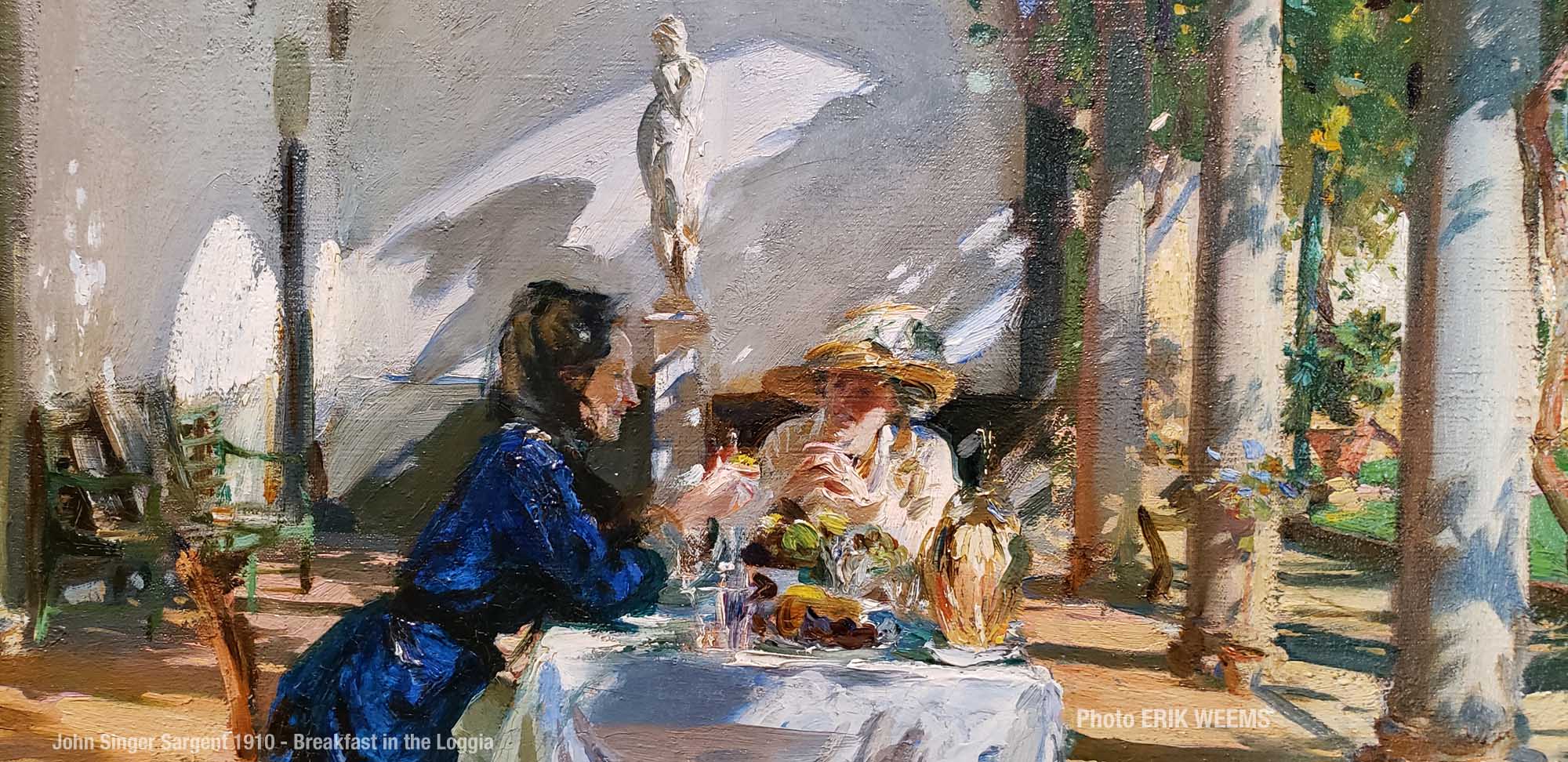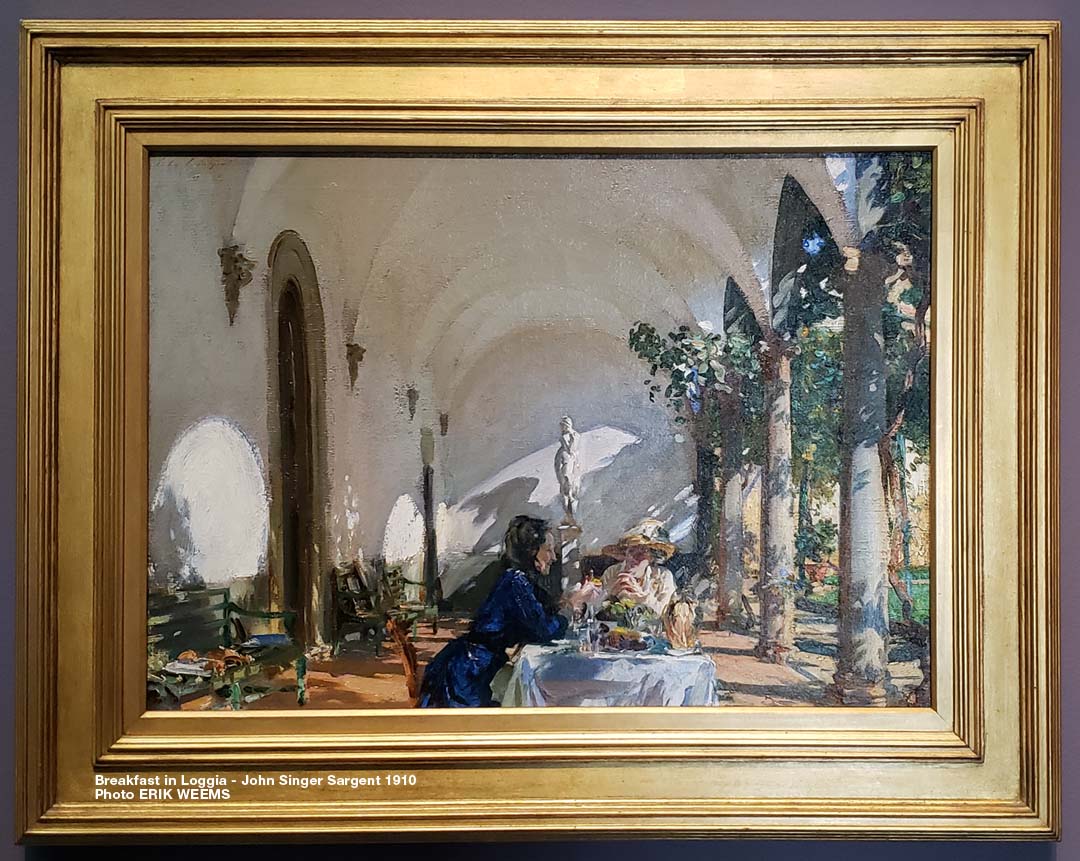Art and Artifice
John Singer Sargent
Breakfast in Loggia, 1910
Size: 20" 1/4 x 27" 15/16 i.e., 51.5 cm x 71 cm (H x W) – Smithsonian measurements. The book John Singer Sargent, Pub. 1999, Tate Gallery Exhibit Catalog, lists the image as 20" 1/2" X 18"

Sargent was staying at the Villa Torre Galli* in Scandicci, a municipality located near Florence in Tuscany, Italy, famous for its beautiful countryside and villas. The structure appears in several Sargent paintings from his stay there and was loaned to him and his party of friends by the Marchese Farinola. Sargent had had influenza in January of 1910 and by the Autumn when he went to Florence he had sworn off his lucrative career as a portrait painter, an action he had been talking about since at least 1906. His tiredness of the genre is expressed at the time in response to an invitation for a portrait:
"Ask me to paint your gates, your fences, your barns, which I would gladly do, but not the human face!"
He had developed a new way of even saying the word "portrait" as "paughtraits" to further express his alienation from the practice, something that in the 21st century would probably be identified as being "burned out."
Sargent was hardly wishing to stop painting, but the task of doing the work of painting an image from a sitter, and also having to deal with the person who could be exacting in how they thought their image should appear, had exhausted him (there is a funny story about a portrait Sargent did of a famous man who dismissed it as poorly done, but his friends looking at the subject seated next to the the finished painting said it was an exact likeness: drooping eye-bags, tired expression, sparse hair, pale skin.)
Identified in the painting Breakfast in Loggia are the American artist Jane de Gahn** and Eliza Wedgwood, also known as Eliza Ruhamah Scidmore Wedgwood, was a friend and patron of John Singer Sargent. She was born on October 29, 1856, in Washington, D.C., and died on June 3, 1928, in England.
There are other paintings made by Sargent during his stay at the Villa Torre Galli, for example Ladies in a Garden which appears to be the figure of Jane de Gahn duplicated in various positions about the Villa Torre Galli, and another view of the Loggia with a somewhat more sombre coloring known as Villa Torre Galli: the Loggia.***
Where Sargent is so bold and modern is in the way he paints his models in close-up, sometimes appearing to be above and on top of them, foreshortening their bodies, flattening the space and cropping details of the image like a photographer. He is more concerned than ever with surface texture, and the energy and fluidity of his brushwork creates rhythms and patterns of great intensity. So deeply impasted are some of the oil paintings that figures and landscapes appear to merge in coruscations of pigment and colour." – Page 39, Sargent's Art, 1999 Tate Gallery Exhibit John Singer Sargent catalog.

Footnotes:
* In English, the words "Villa Torre Galli" translate to "Tower Galli Villa."
"Villa" refers to a large country estate or a luxurious residence, often surrounded by gardens or other natural features. It is commonly used to describe grand houses or mansions in Italy.
"Torre" translates to "tower," indicating the presence of a tower or a tall structure within the villa's architecture. Towers were often incorporated into Italian villas for various purposes, such as defensive, decorative, or practical uses.
"Galli" is a surname that could potentially refer to the family name associated with the villa or a previous owner. It does not have a specific meaning in this context.
** Jane de Glehn, also known as Jane Emmet or Jane Erin Emmet de Glehn, was an American artist who was frequently depicted in paintings by John Singer Sargent. She was born on March 3, 1873, in New Rochelle, New York, and passed away on September 13, 1961, in London, England.
*** Loggia: The Italian word "loggia" refers to a covered, open-sided gallery or balcony that is typically supported by columns or arches. These structures are commonly found in Italian architecture and often attached to buildings to provide a sheltered outdoor space. They can be seen with residential buildings, palaces, churches, and public squares, among other uses.
Links:
More About this painting at the Freer Art Gallery Smithsonian Museum Freer Gallery
The Metropolitan Museum in NYC website has an image of the Villa Torre Galli: the Loggia
Classical Painting Atelier: A Contemporary Guide to Traditional Studio Practice - AMAZON Published by Watson-Guptill, 256 pages
Original Page July 14, 2023


